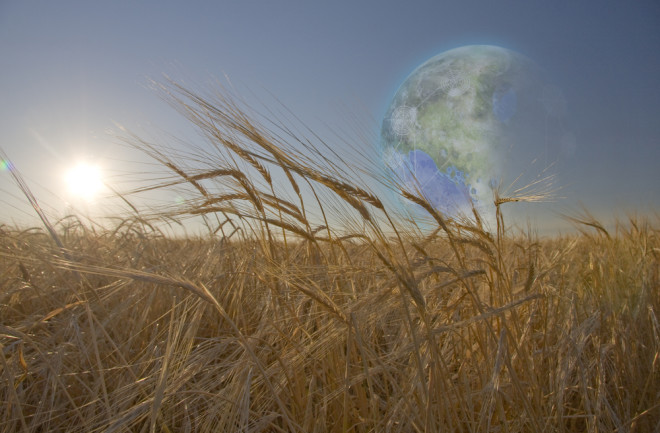One of the key developments separating modern civilization from the hunter gatherer societies of the past is the invention of farming, which took place about 10,000 years ago. This began with the cultivation of wild plants and the domestication of various animals for dairy products and meat.
The big advantage of farming is that it sustains a much larger population than hunting and gathering. This led to the emergence of cities, the sharing of natural resources and of ideas and innovations.
It has also had a big impact on the Earth itself. The effects of farming are visible in the grid-like arrangement of fields, in the way light is reflected from photosynthetic plants and in the chemicals it releases into the atmosphere, particularly by industrial-scale agriculture.
Now a group of astronomers and astrobiologists say this atmospheric signature must be clearly visible from space and that a similar signal could also be generated by a farm on another planet. “The spectral signature of such an “ExoFarm” is worth considering in the search for technosignatures,” say Jacob Haqq-Misra at the Blue Marble Space Institute of Science in Seattle, and colleagues. They go on to explore what such a signature might look like and how easily it could be detected by the current generation of space telescopes such as the James Webb.
Nitrogen Fixing
An essential element of agriculture is the application of fertilizer to increase productivity. This gives plants improved access to nitrogen, a crucial element of life. Nitrogen is readily available as N2 which makes up 78 per cent of the atmosphere.
But fixing it in a plant-usable form is tricky because N2 is bound together by a highly stable triple bond. This nitrogen is naturally broken down into more easily exploited forms in a variety of ways ranging from lightning strikes to the microorganisms in manure.
But as the population has increased, particularly since the industrial revolution, the demand for nitrogen fertilizers has exploded. This has led to the development of artificial fertilizers and a global industry dedicated to manipulating the nitrogen cycle via an industrial approach to creating ammonia called the Haber-Bosch process.
This produces vast amounts of ammonia, some of which escapes into the atmosphere, albeit for short periods of time since ammonia usually falls to ground after a few days. So detectable levels of ammonia in the atmosphere must be the result of significant ongoing agricultural activity.
Although atmospheric ammonia is short-lived, its use as a fertilizer produces nitrous oxide (N2O), a greenhouse gas that survives in the atmosphere for over one hundred years.
Nitrous oxides are also produced by combustion. However, Haqq-Misra and co point out that other civilizations may discover, like us, that combustion is not sustainable and phase it out. So in the long run, the signature of nitrous oxides is more likely to indicate agricultural activity.
Agriculture is also the main producer of atmospheric methane on Earth. So CH4 is another signature worth looking for, say the team. “The signature of such an ExoFarm could only occur on a planet that already supports photosynthesis, so such a planet will necessarily already show spectral features due to H2O, O2, and CO2,” say Haqq-Misra and co.
Extraterrestrial Technosignature
“These calculations suggest the possibility of considering the simultaneous detection of NH3 and N2O in an atmosphere that also contains H2O, O2, and CO2 as a technosignature for extraterrestrial agriculture.”
It may be possible to detect this signature on other planets using today’s observatories. The researchers point out that the James Webb Space Telescope, currently being commissioned, should be able to detect ammonia at the level of five parts per million in the atmosphere of a hydrogen-rich planet orbiting a nearby red dwarf. Current levels of ammonia on Earth are about ten parts per billion.
That makes the search for nitrogen signatures an interesting pursuit for astrobiologists. It is likely that the hunt for this signal would be a natural next step after the discovery of photosynthetic signatures.
What seems clear is that technosignatures are unlikely to be single WOW-type signals but more complex patterns of evidence that require some dedicated detective work. And with the James Webb Telescope coming online later this year, that detective work might just be about to begin.
Ref: Disruption of a Planetary Nitrogen Cycle as Evidence of Extraterrestrial Agriculture : arxiv.org/abs/2204.05360

